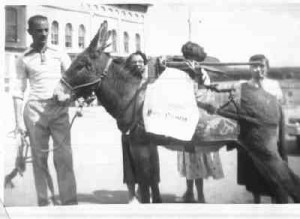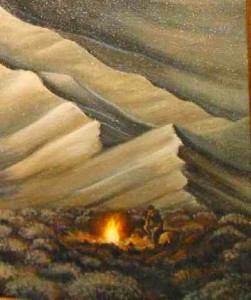Review by Virginia M. Simmons
Utes – July 2004 – Colorado Central Magazine
The Utes Must Go!: American Expansion and the Removal of a People
By Peter R. Decker
published by Fulcrum Publishing, 2004
ISBN 1-55591-465-9
GLANCING AT THE MAIN TITLE OF Peter R. Decker’s new book The Utes Must Go!, one might assume that the volume will be a repetition of the familiar story about the removal of Colorado’s Ute Indians to reservations. Unfortunately, because of the artistry of a book designer, the subtitle, American Expansion and the Removal of a People, may be overlooked despite its being the linchpin of a new interpretation of an old story. By grounding his account in the westward expansion of America and also contributing original research into the lives of some of the players, Decker has significantly advanced the study of the Ute Indians of Colorado and our region’s history.
As many readers will recognize, the book’s title comes from the outcry that arose after the murder of Nathan Meeker and his employees at the White River Agency in northwest Colorado, and the abduction of the women and children from the agency’s ruins. The subtitle refers to the expansion of the continental empire that became the equivalent of a mandate after the Louisiana Purchase. Decker writes that the “proper dominion” of the United States under John Quincy Adams was considered to be the entire North American continent, and Missouri’s Senator Thomas Hart Benton “added to Adams’s territorial obligation his own racial imperative that only the white race had ‘received the divine command to subdue … the continent’.”
Decker acknowledges that the process began earlier than the 1800s, though, and another volume I’ve read, The American West by Robert V. Hine and John Mack Faragher (Yale University, 2000), ascribes the beginnings of westward expansion in North America to the Spanish conquest, and next to the effects on Indian populations by English colonization in Virginia and by the Puritans of Massachusetts Bay.
The removal of Colorado’s Ute Indians was a logical outgrowth of this intentional movement. The Ute removal Decker writes about was unique only in its late coming. President Andrew Jackson and congress had facilitated this process decades earlier with the “Indian Removal Act” of 1830.
Decker also summarizes Grant’s Peace Policy, which resulted from the nineteenth century’s reform movement, and was espoused by Easterners who recognized the need for a humanitarian approach to the Indian problem.
Within the context of westward expansion and the reform movement, Decker presents the events at the White River Agency which finally resulted in the Ute removal. In the process he also presents a remarkable biography of Nathan Meeker, as a figure in a movement that spawned both the reform movement and utopian idealism. Meeker lived for a time in an agricultural community of Fourier followers, and eventually, for better or worse, he became the founder of the Union Colony at Greeley, Colorado, and an Indian agent in northwestern Colorado. Decker provides information about Meeker’s career as a writer and his relationship with his sponsor, Horace Greeley, in interesting detail.
The Utes Must Go! makes it clear that Meeker’s convictions and his personality contributed to the frustrating and tragic events at White River, but it also shows that certain Indians shared responsibility. Some readers, however, might wish to learn more about the policies of the Bureau of Indian Affairs regarding agriculture as a tool of assimilation — a policy in harmony with Meeker’s ideas.
If one is to criticize this book, the argument could be made that too much space is devoted to the events at White River, most of which have already been told and retold to the point of redundancy, as has the story of the associated battle. Decker does, however, offer new, very welcome information in his account of the actions and attitudes of U.S. Senator Henry Teller and of Governor Frederick Pitkin, a mine owner and vigorous advocate of Ute removal.
THE AUTHOR DOES NOT ATTEMPT to tell the entire story about the Utes and their removal to reservations, though. For instance, in contrast to the lengthy treatment of the Meeker episode, something more could have been presented about agents like Charles Adams and John Critchlow who enjoyed some success but lost their jobs, thanks to bureaucratic myopia.
Or the author could have included more about other Ute bands, and thereby addressed numerous questions, such as: Why was Ouray’s band removed from the Uncompahgre? What were the steps taken during the removal of the Northern Utes? What about the Ute Indians who had already been removed from New Mexico to southwestern Colorado? Which Ute bands were given Indian farms before being sent off to a reservation? Why did some Ute Indians remain off reservation in Utah? What events increased the anger of Ute Indians and the fear among settlers before White River? And why was there agitation for removal of the Utes before the Meeker disaster?
This volume offers the imprimaturs of United States Senator Ben Nighthorse Campbell and Native American scholar Vine Deloria, Jr., a smattering of illustrations, an index, endnotes, but, oddly, no bibliography. By examining the endnotes, one can unearth which materials Decker was using and not using, but a bibliography would have served better.
Decker has included primary resources such as government documents, a number of scholarly but ancillary publications, and a few that are more narrowly focused, but there’s a dearth of very good regional materials which could have sharpened his treatment.
The value of Decker’s work lies in his exemplary original research in the Letterbooks of the American Unitarian Association and the archival papers of figures such as Nathan Meeker, Horace Greeley, Carl Schurz, Henry Teller, and Frederick Pitkin. Its weakness seems to result from Decker’s heavy reliance on readily available sources like Marshall Sprague’s Massacre, which is a wonderfully readable narrative, but it contains some data that Sprague himself described as being his own “reconstruction.” Decker seems to have derived a good deal of his information about the Meeker massacre and the battle on Milk Creek from Sprague without recognizing the perils in doing so.
ANOTHER QUESTIONABLE SOURCE is Robert Emmitt’s The Last War Trail, which includes material compiled by a journalist in interviews with Ute Indians in the mid-1900s. Although second-, third-, or fourth-hand accounts can be valuable for understanding a culture’s collective memory and family lore, a historian must critically evaluate their reliability.
As Decker relates in his Preface, he was digging postholes on his ranch near Ridgway when he found broken arrowheads and pieces of chert that roused his curiosity about the people who had once lived there. The Utes Must Go does not respond to his reverie with information about the Ute tribe as a whole or about the tribe’s bands. One is forced to conclude that Decker’s interests do not include the minutiae of Ute or Colorado history, which might have helped him avoid a few missteps. For instance, he put Governor Alexander Hunt (instead of Governor John Evans) at the council at Conejos in 1863; he misplaced the cave where Chief Ouray was buried; and he misunderstood the original distribution of Ute Indians in North America.
History is a science. A historian must assemble facts, even the tedious minutiae, analyze their informational value, interpret their significance inductively, and then formulate a conclusion. When a writer starts with a predetermined conclusion and then seeks only the data that might support his thesis, as happens much too often, the product is flawed or, at best, incomplete.
A fence is not a real fence until all of the posts are set and all of the wire has been strung. In The Utes Must Go! the author has set a number of good, stout fenceposts, and added some new wire, but he has also stapled in a few rusty old strands and left some gaps wide enough for cattle to walk through. Nonetheless, the book introduces a focus for future students of Ute history to advance, until the entire herd is securely fenced.
Formerly a professor of history and public policy at Duke University, Peter R. Decker is a rancher. He has served as director of the National Western Stock Show and is presently the chairman of Fort Lewis College’s Board of Trustees. Decker previously wrote an acclaimed account about the transformation of Ridgway, Colorado in Old Fences, New Neighbors.


